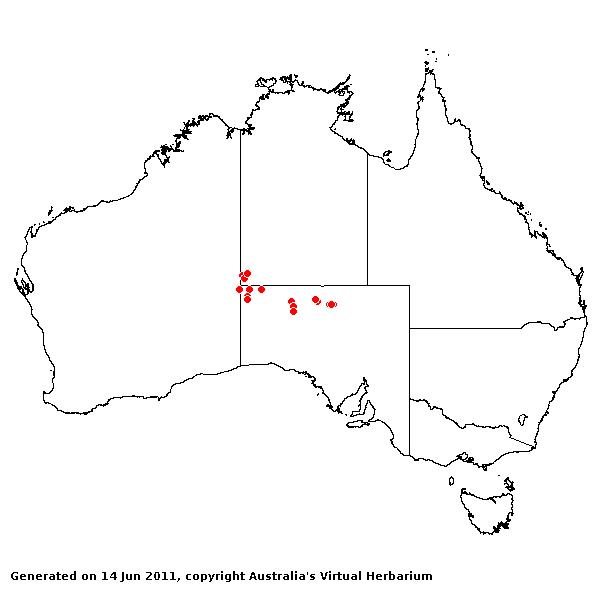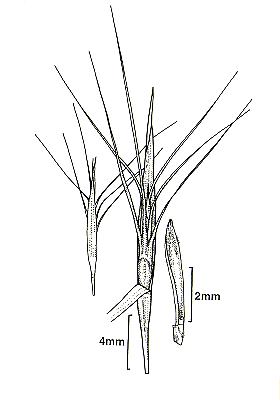Triodia helmsii (C.E. Hubb.) M.
Lazarides. Aust. Syst. Bot. 10: 434 (1997).
Classification. (GPWG 2001) : Subfamily Chloridoideae. Triodeae.
Basionym and/or
Replacement Name: Plectrachne
helmsii C.E. Hubb., Bull. Misc. Inform. Kew 1941: 29 (1941).
Type of Basionym or
Protologue Information: Australia: South Australia: Everard Range, 8 Jun
1891, Helms s.n. (HT: K; IT: AD, BRI (fragm. & photo), MEL, NSW (2
sheets), PERTH (& photo of HT)).
Key references
(books and floras): [1981] M.Lazarides in J.Jessop (ed)., Flora of
Central Australia (446 as Plectrachne), [2002] D.Sharp &
B.K.Simon, AusGrass, Grasses of Australia, [2006] J.Jessop,
G.R.M.Dashorst, F.M.James, Grasses of South Australia (412).
Illustrations:
[2005] K.Mallet (ed.), Flora of Australia 44B: Poaceae 3 (Fig.
35G-I), [2006] J.Jessop, G.R.M.Dashorst, F.M.James, Grasses of South
Australia (413, fig. 342).
Habit.
Perennial. Culms erect, 50–130 cm tall, 2 -noded. Lateral branches simple.
Leaf-sheath auricles absent. Ligule a fringe of hairs. Leaf-blades aciculate,
conduplicate, 6.5–23 cm long, 1–2 mm wide. Leaf-blade surface indumented.
Inflorescence.
Inflorescence compound, a panicle. Panicle linear or oblong, 10–17 cm long,
1.5–2 cm wide.
Spikelets.
Spikelets pedicelled. Fertile spikelets many flowered, with at least 2 fertile
florets (3–4), comprising 3–4 fertile floret(s), with diminished florets at the
apex, oblong, laterally compressed, 11–15 mm long.
Glumes.
Glumes similar. Lower glume lanceolate, chartaceous or scarious, much thinner
on margins, without keels, 5–7 -nerved. Lower glume surface glabrous. Lower
glume apex muticous or mucronate. Upper glume lanceolate, 12–21 mm long,
chartaceous or scarious, without keels, 5–7 -nerved. Upper glume surface
asperulous, glabrous. Upper glume apex entire, muticous or mucronate.
Florets.
Fertile lemma 4.5–5 mm long, without keel, 3 -nerved. Lemma surface indumented.
Lemma apex lobed, awned, 3 -awned. Median (principal) awn pseudo-articulate
across body of lemma, 8–12 mm long overall. Lateral lemma awns present. Palea 2
-nerved. Lodicules present. Anthers 3.
Continental Distribution:
Australasia.
Australian
Distribution: Western Australia, Northern Territory, South Australia.
Western Australia:
Giles, Helms. Northern Territory: Central Australia South. South
Australia: North-western, Lake Eyre.
Notes.
Distinguishing characters include the loosely flowered spikelet with 3–4
fertile florets; two-textured lemma with long callus and usually appressed
pubescence; glabrous one-textured palea subequal to the body of its lemma;
relatively wide lemma lobes; subequal glumes somewhat longer than the spikelet;
and pubescent rachilla internodes. P. helmsii is similar to P.
pungens and P. schinzii in the bitextured, pubescent lemma, but
differs by its uniformly textured palea and smaller spikelet. The prominent
spur on the internode between the lower and upper glumes, which characterizes
the type, has not been observed on the other specimes examined.
In
the vicinity of the border junction of W.A., S.A. and the N.T. On skeletal
rocky hillslopes; also on sand dunes and plains in red sands and sandy loams;
flowers June-Oct.



